‘Three strikes and we are out’: unionism and activism in London archaeology
Ian Blair
Forty-five years ago on the 30 April 1978, an estimated 100,000 people including archaeologists from the Department of Urban Archaeology (DUA) took part in a march from Trafalgar Square to Victoria Park co-organised by ‘Rock Against Racism’ and the ‘Anti-Nazi League’, which culminated in a concert headlined by the Clash and Tom Robinson.
The march was organised as a show of solidarity against the National Front and oppose the rise of far-right groups in the United Kingdom.
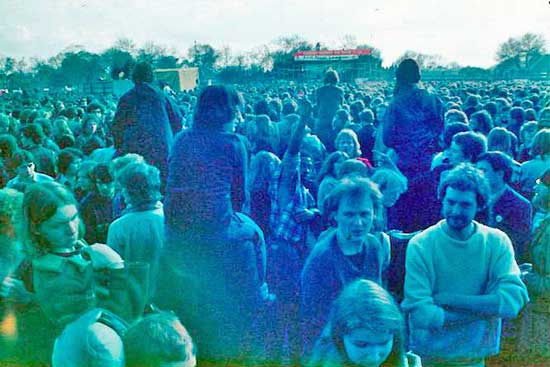 Rock against Racism concert at Victoria Park in April 1978
Rock against Racism concert at Victoria Park in April 1978
(Photo: Derek Gadd & Steve Roskams)
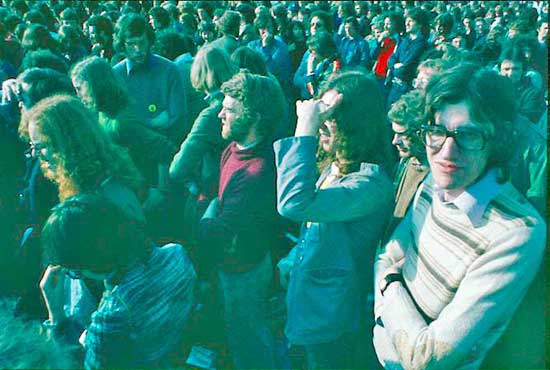 Rock against Racism concert at Victoria Park in April 1978 with Steve Roskams (centre) (Photo: Derek Gadd & Steve Roskams)
Rock against Racism concert at Victoria Park in April 1978 with Steve Roskams (centre) (Photo: Derek Gadd & Steve Roskams)
Soon after the DUA’s formation in 1973, the staff of the fledgling unit became the first professional archaeologists with union representation, when in December 1974 they joined the ‘Association of Scientific, Technical and Managerial Staffs (ASTMS)’ trade union. When I joined the DUA four years later the unit was affiliated to the ‘Institution of Professional Civil Servants (IPCS)’, which following privatisation of the jobs of many of its members changed its name in 1989 to the ‘Institution of Professionals, Managers and Specialists (IPMS)’. In 2001, it merged with the Engineers’ and Managers’ Association to form ‘Prospect’. Four decades on and having left MOLA I still remain a paid-up ‘retired’ member of Prospect: a habit that is difficult to break as the union was an integral part of my entire working life.
Another notable milestone was reached on 22nd June 1979 when the first union strike by a body of professional archaeologists in the country was by the DUA, in sympathy with the pay claim by IPCS members on Professional, technological, and scientific grades.
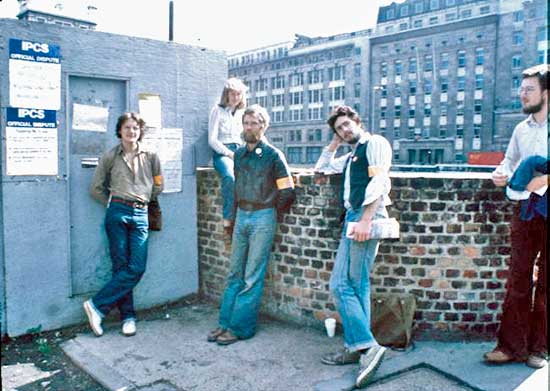 Picket line outside the GPO Newgate Street site in June 1979: featuring from left to right: Derek Gadd, Annie Upson, Steve Roskams, John Milner, ??
Picket line outside the GPO Newgate Street site in June 1979: featuring from left to right: Derek Gadd, Annie Upson, Steve Roskams, John Milner, ??
(Photo: Derek Gadd & Steve Roskams)
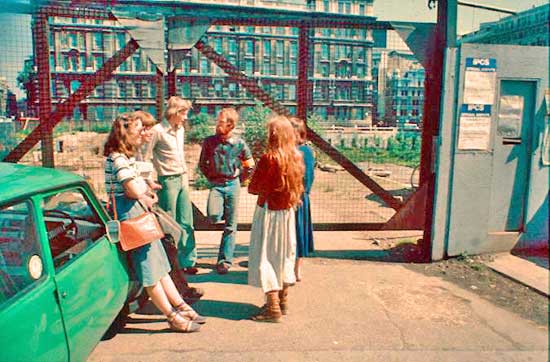 Picket line outside the gates of the GPO Newgate Street site in June 1979: featuring from left to right: Charlotte Harding, Monique Borgerhoff Mulder, Mike Lee, Steve Roskams, Marietta Ryan, Lucy Walker (Photo: Derek Gadd & Steve Roskams)
Picket line outside the gates of the GPO Newgate Street site in June 1979: featuring from left to right: Charlotte Harding, Monique Borgerhoff Mulder, Mike Lee, Steve Roskams, Marietta Ryan, Lucy Walker (Photo: Derek Gadd & Steve Roskams)
Archaeologist Derek Gadd was the Museum of London (MoL) IPCS branch secretary at the time and provided the following background to the strike:
‘I don’t think I have ever told you the story of the strike. I was MoL IPCS branch secretary and received a standard circular to all branches giving information on the union’s decision to hold a one-day strike. In the face of management intransigence (especially from the Corporation of London) on negotiations on issues such as contracts of employment for DUA staff, I had been itching to put a shot across their bows and called a meeting ‘informing’ everyone that we were going on strike (it was before Thatcher’s trade union laws which required strike ballots). A few days later, union HQ contacted me when two members resigned from the union over the strike asking me what I was doing – MoL was a ‘fringe body’ totally unaffected by the issue that the strike had been called on. I replied that, having held the meeting my credibility as branch secretary was on the line, so they shrugged and told me to go ahead. And the rest, as they say, is history.’
The 1970s-1980s saw increasing unionism and radicalism in archaeology notably amongst the archaeologists of the DUA, who participated in countless marches and demonstrations, which saw banners being made by site staff to march against the Corrie anti-abortion Bill (Women’s March) on 28 October 1979. The front covers of the DUA newsletter ‘Radio Carbon’ dated June 1979 and March 1980 bear testament to this ingrained activism amongst the archaeological staff during this period.
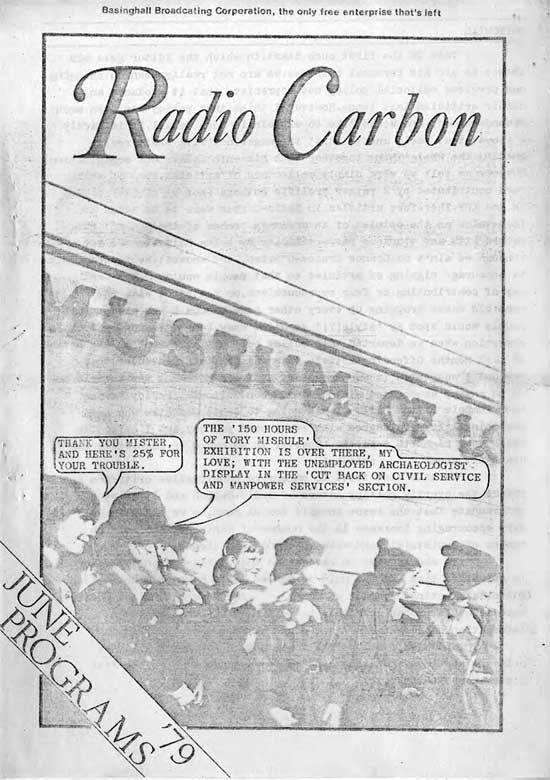 Front cover of Radio Carbon for June 1979
Front cover of Radio Carbon for June 1979
(From Louise Miller)
 ‘DUA on the March’: Front cover of Radio Carbon for March 1980
‘DUA on the March’: Front cover of Radio Carbon for March 1980
(From Nick Bateman)
In June 2008 twenty-nine years after the DUA strike of 1979, MoLAS archaeologists following the lead of their archaeological forebearers were once again standing on a picket line - this time outside the MoLAS offices at Eagle Wharf Road in Hackney, in protest at a derisory 2% pay award; less than half the rate of inflation; and thirteen months late. Significantly, it was the first time a strike extended across the entire Museum group, and the first ever strike at the Museum of London Archaeology Service and the Museum in Docklands. The strike was timed to coincide with the TUC holding a rally at the Central Hall in Westminster and a lobby of MPs, and received widespread media coverage, including a page spread in the Autumn 2008 issue of Rescue News.
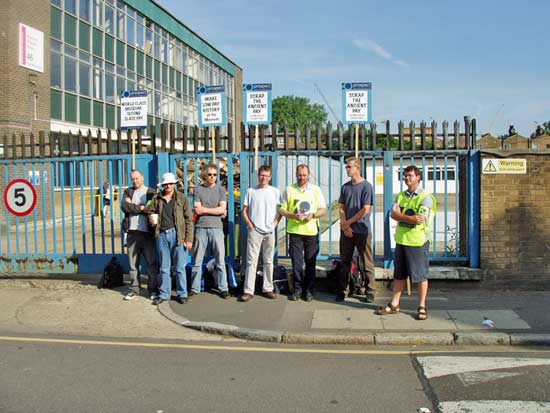 Picket line outside MoLAS in June 2008: featuring from left to right: Jez Taylor, Pete Cardiff, Ian Blair, Antony Francis, Bruce Watson, Bruno Barber, Rupert Featherby
Picket line outside MoLAS in June 2008: featuring from left to right: Jez Taylor, Pete Cardiff, Ian Blair, Antony Francis, Bruce Watson, Bruno Barber, Rupert Featherby
(Photo: Antony Francis)
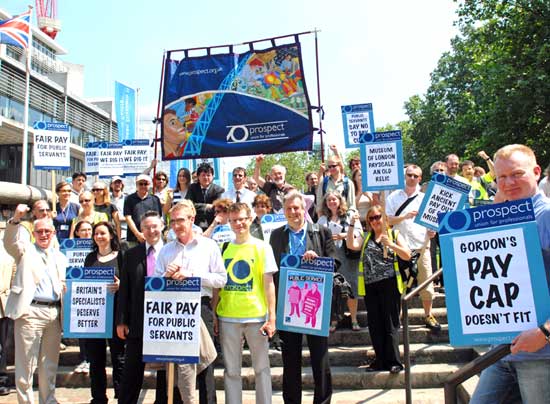 Having commandeered a bus from Hackney into Westminster MoLAS archaeologists mass with Museum of London staff under the Prospect banner outside the QE11 Conference Centre (Photo: Antony Francis)
Having commandeered a bus from Hackney into Westminster MoLAS archaeologists mass with Museum of London staff under the Prospect banner outside the QE11 Conference Centre (Photo: Antony Francis)
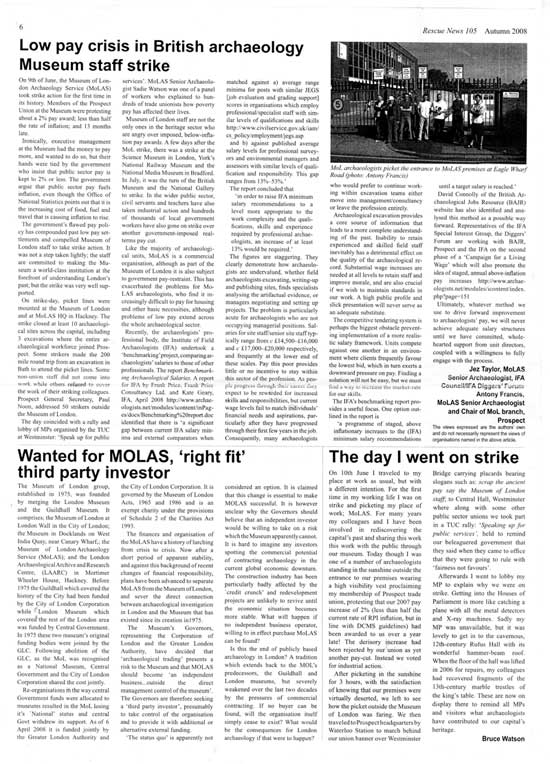 Rescue News article detailing the combined MoLAS and Museum of London strike held on 9 June 2008
Rescue News article detailing the combined MoLAS and Museum of London strike held on 9 June 2008
Sadly, eleven years later on 11th December 2019, the same age-old scenario of low pay and the lack of a meaningful incremental salary structure amongst the archaeological staff at MOLA, led to another one-day strike and picket lines. Forty years on from the strike outside the GPO Newgate Street site and the sad realisation that the struggle for a liveable wage and decent pay and conditions for London archaeologists was still a battle being waged.
** An acknowledgement and thanks should be made to all of the union reps who have selflessly stood up to the plate since 1974 and fought for the rights of the London archaeologists. It is testament to their collective efforts that so much has been achieved on behalf of the union members despite the many seemingly insurmountable obstacles that lay or had been placed in their way.
(RIP Angus Stephenson (1951-2023))

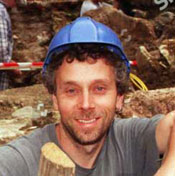

Comments powered by CComment